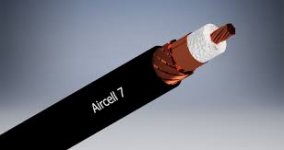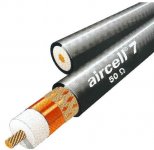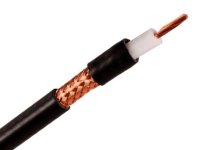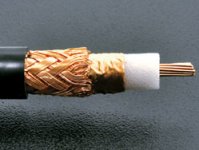terminating the braides shields.
My technique goes like that:
Start on the opposite side of where you will need the twisted shield, and with a needle (an eel?) unbraid it by steps of not too many millimeters. In the end, you should have a more or less straight, more or less even halved string of shield-wires. Pull them around the cable and twist.
If this does not work out, cut along the wire, although you loose copper [emoji41]
These are the top 3:I cam to the same conclusion wrt maths. But do you know a place to source the bluejeans? And a bit worried about terminating the braides shields.
Canare LV-77S
Belden 1505F
Canare L-5CFB
I would be surprised if you couldn't find at least one of them?
How long is the interconnect going to be, 3 feet? The resistance of any of those cables is irrelevant for a line level signal at those distances.
These are the top 3:
Canare LV-77S
Belden 1505F
Canare L-5CFB
I would be surprised if you couldn't find at least one of them?
I will check it out. Not sourced in Norway I am sure, but nevertheless need to order from abroad so I just need to broaden my search. Thanks, man!
My technique goes like that:
Start on the opposite side of where you will need the twisted shield, and with a needle (an eel?) unbraid it by steps of not too many millimeters. In the end, you should have a more or less straight, more or less even halved string of shield-wires. Pull them around the cable and twist.
If this does not work out, cut along the wire, although you loose copper [emoji41]
Nice! I don’t think I would have thought of that... thanks!
The one you found is going to be just fine.Plan is 1,5 feet approx =D
hi guys has anyone tried these plugs ??
AudioQuest RCA-800 Premium RCA Plugs - Pack of 4 | Future Shop
i emailed the company asking for a datasheet, but was refused. the guy emailed me back stating
" Dear Gaz,
They're made from beryllium copper. The plating is applied directly over the copper, hence "direct gold" or "direct silver" plated. None of our connectors use an intermediate layer of nickel."
let me know what you think
gaz
AudioQuest RCA-800 Premium RCA Plugs - Pack of 4 | Future Shop
i emailed the company asking for a datasheet, but was refused. the guy emailed me back stating
" Dear Gaz,
They're made from beryllium copper. The plating is applied directly over the copper, hence "direct gold" or "direct silver" plated. None of our connectors use an intermediate layer of nickel."
let me know what you think
gaz
Nope. Just buy some quality Neutrik connectors for a few bucks each and put the money into something that matters.
Hificollective=UK, Acoustic-dimension=eu
ok, hificollective has a reallyreally great parts-catalogue, but—they're in the UK, which seems to have become a major obstacle for us continentals... check out Acoustic-Dimension, high-end audio and components for tube audio for a not nearly as great but still very nice catalogue...
ok, hificollective has a reallyreally great parts-catalogue, but—they're in the UK, which seems to have become a major obstacle for us continentals... check out Acoustic-Dimension, high-end audio and components for tube audio for a not nearly as great but still very nice catalogue...
A year of consideration is over and I pulled the plug on Mogami 2964. First off is internal signal wiring for the Aleph J, replacing twisted pair Cat 6. Ordered a few REAN’s too, iot try them as signal cables. Maybe I’ll rewire my Wayne linestage too 🙂
Thanks for all good advice helping me to this preliminary conclusion. Hope it turns out nice.
btw, found it at audiophonix in France by the meter.
regards,
Andy
Thanks for all good advice helping me to this preliminary conclusion. Hope it turns out nice.
btw, found it at audiophonix in France by the meter.
regards,
Andy
Highest sonic performance you will get only with solid core wires (both inner conductor and screen).
Examples are this one:
http://www.rfcell.com/air-dielectric
and those from images No 1 and 2
A very big disadvantage is the lack of flexibility and the laborious process of attaching the connectors (rca plugs) using only additional short wires.
A bit more easy is the MICRO-COAX Cinch-RCA 2x 25cm (Semi-Rigid) - Typ UT-141 - go to
http://www.semi-rigid.com/uploads/cables/images/20110809214439_drawing_UT-141A-TP.pdf
and
https://m.ebay-kleinanzeigen.de/s-a...hnl-isoda-cardas-nf-verb-/1416622896-172-4440
and images No 3-5
The cables that are easy to manage and come closest to those previously mentioned in terms of sound quality are flat line resp. flex versions like the follow:
Ephemera Interconnect Cable
https://en.sternklang.xyz/products/ephemera/index.html
Nordost Red Dawn Flat
http://www.soundstagenetwork.com/todd09.htm
https://www.adverts.ie/cables/nordost-flat-line-gold-mkii-interconnects/2623840
Bastanis Heartbeat I/C- cables
https://www.bastanis.com/audio/cables/interlink-heartbeat
check out also the images No 6-9
I am looking for suppliers, which offer such cables for sold by the meter - thanks for advices.
From the flexible coax versions the best sounded I know is the Mogami Absolute Pure 2803 - for sold by the meter go to
https://www.cma.audio/detail/index/sArticle/1811
and review
http://www.highfidelity.pl/@main-586&lang=en
and image No 13 (last image)
An inexpensive universal coax RCA interconnect cable (e. g. between CD-Player and amplifier or between pre- and power-amplifier) is the Hirschmann Koka 799 - usually used as a connection between satellite receiver and dish (parabolic) antenna (LNC) - go to
https://www.hirschmann-multimedia.com/media/files/298799102 KOKA 799 Eca 100 m black productsheet v17.1.pdf
and Image No 10
Better than the most commercial available high quality RCA interconnect parts in a soft and flexible design - as mostly to find.
If low capacitance character is important, twisted versions are a good solution like the Kimber versions from Image No 11+12
Examples are this one:
http://www.rfcell.com/air-dielectric
and those from images No 1 and 2
A very big disadvantage is the lack of flexibility and the laborious process of attaching the connectors (rca plugs) using only additional short wires.
A bit more easy is the MICRO-COAX Cinch-RCA 2x 25cm (Semi-Rigid) - Typ UT-141 - go to
http://www.semi-rigid.com/uploads/cables/images/20110809214439_drawing_UT-141A-TP.pdf
and
https://m.ebay-kleinanzeigen.de/s-a...hnl-isoda-cardas-nf-verb-/1416622896-172-4440
and images No 3-5
The cables that are easy to manage and come closest to those previously mentioned in terms of sound quality are flat line resp. flex versions like the follow:
Ephemera Interconnect Cable
https://en.sternklang.xyz/products/ephemera/index.html
Nordost Red Dawn Flat
http://www.soundstagenetwork.com/todd09.htm
https://www.adverts.ie/cables/nordost-flat-line-gold-mkii-interconnects/2623840
Bastanis Heartbeat I/C- cables
https://www.bastanis.com/audio/cables/interlink-heartbeat
check out also the images No 6-9
I am looking for suppliers, which offer such cables for sold by the meter - thanks for advices.
From the flexible coax versions the best sounded I know is the Mogami Absolute Pure 2803 - for sold by the meter go to
https://www.cma.audio/detail/index/sArticle/1811
and review
http://www.highfidelity.pl/@main-586&lang=en
and image No 13 (last image)
An inexpensive universal coax RCA interconnect cable (e. g. between CD-Player and amplifier or between pre- and power-amplifier) is the Hirschmann Koka 799 - usually used as a connection between satellite receiver and dish (parabolic) antenna (LNC) - go to
https://www.hirschmann-multimedia.com/media/files/298799102 KOKA 799 Eca 100 m black productsheet v17.1.pdf
and Image No 10
Better than the most commercial available high quality RCA interconnect parts in a soft and flexible design - as mostly to find.
If low capacitance character is important, twisted versions are a good solution like the Kimber versions from Image No 11+12
Attachments
-
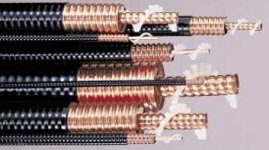 andrew-heliax-air-dielectric-cables.jpg27.7 KB · Views: 182
andrew-heliax-air-dielectric-cables.jpg27.7 KB · Views: 182 -
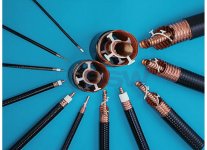 andrew_heliax_cell dielectr.cable.jpg117.1 KB · Views: 168
andrew_heliax_cell dielectr.cable.jpg117.1 KB · Views: 168 -
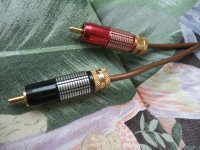 MICRO-COAX Cinch-RCA 2x 25cm (Semi-Rigid) - Typ UT-141.jpg174.2 KB · Views: 210
MICRO-COAX Cinch-RCA 2x 25cm (Semi-Rigid) - Typ UT-141.jpg174.2 KB · Views: 210 -
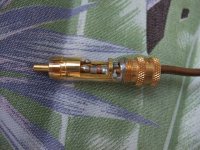 MICRO-COAX Cinch-RCA 2x 25cm (Semi-Rigid) - Typ UT-141-III.jpg164.3 KB · Views: 189
MICRO-COAX Cinch-RCA 2x 25cm (Semi-Rigid) - Typ UT-141-III.jpg164.3 KB · Views: 189 -
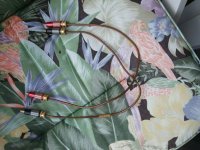 MICRO-COAX Cinch-RCA 2x 25cm (Semi-Rigid) - Typ UT-141-II.jpg131.7 KB · Views: 168
MICRO-COAX Cinch-RCA 2x 25cm (Semi-Rigid) - Typ UT-141-II.jpg131.7 KB · Views: 168 -
 nordost-red-dawn RCA-Cinch.jpg69.3 KB · Views: 163
nordost-red-dawn RCA-Cinch.jpg69.3 KB · Views: 163 -
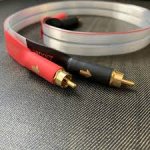 Nordost Red Dawn RCA Interconnect-III.jpg12.6 KB · Views: 160
Nordost Red Dawn RCA Interconnect-III.jpg12.6 KB · Views: 160 -
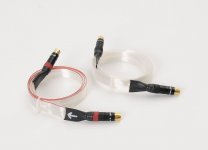 Nordost Red Dawn RCA Interconnect-II.jpg68.6 KB · Views: 200
Nordost Red Dawn RCA Interconnect-II.jpg68.6 KB · Views: 200 -
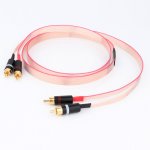 Nordost Red Dawn RCA Interconnect.jpg96.8 KB · Views: 230
Nordost Red Dawn RCA Interconnect.jpg96.8 KB · Views: 230 -
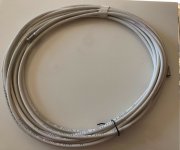 Hirschmann KOKA 799.jpg66 KB · Views: 159
Hirschmann KOKA 799.jpg66 KB · Views: 159 -
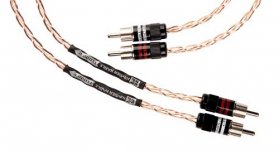 l_Kimber-Timbre-3-NF-Kabel.jpg12.1 KB · Views: 156
l_Kimber-Timbre-3-NF-Kabel.jpg12.1 KB · Views: 156 -
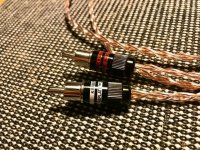 Kimber Tinbre 3.jpg195.9 KB · Views: 191
Kimber Tinbre 3.jpg195.9 KB · Views: 191 -
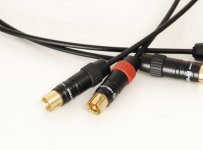 Mogami Absolute Pure 2803.jpg52.7 KB · Views: 177
Mogami Absolute Pure 2803.jpg52.7 KB · Views: 177
Last edited:
Its absolutely fine to use multi-strand wiring for audio signals, this isn't microwaves... The idea of using heliax for 20kHz is complete over-engineering! Hard and semi-hard coaxs are what you might find in quality RF test equipment to prevent RF leakage affecting performance at 100's of MHz and up. Not needed for audio, unless, perhaps, you are routing past an industrial welding machine for some reason, or perhaps through a working microwave oven? Then it would be needed.Highest sonic performance you will get only with solid core wires (both inner conductor and screen).
What is "sonic performance" anyway? We're talking analog signal propagation at audio bandwidths. This is electronics, nothing "sonic" is involved between the microphone and the speaker. Performance is measured by such parameters as gain-flatness, distortion, noise, etc, general issues with analog signals whatever they represent. Every time I see "sonic" used in this context I get a quaesy feeling about snake oil and marketing.
Heli-ax is the stuff we use to run to our transmitter antenna! The stuff is huge! Like a foot in diameter and more.
both Mogami and Canare make great flexible cable that will do the job.
both Mogami and Canare make great flexible cable that will do the job.
There's no need to buy overpriced stuff, basic quality general-purpose coax cables are fine for audio - pop to an electronics supplier and have a look. There's mini RG59 for instance which is pretty flexible, availble with dual braid and foil shield. 30p/metre in UK. What's that, about 5% the cost of the snake oil stuff or so? No-brainer.
That's exactly what most electronic experts say (most of them anyway say that in the audible audio band below 20 KHz the whole cable discussion belongs completely in the esoteric realm).Its absolutely fine to use multi-strand wiring for audio signals, this isn't microwaves... The idea of using heliax for 20kHz is complete over-engineering! Hard and semi-hard coaxs are what you might find in quality RF test equipment to prevent RF leakage affecting performance at 100's of MHz and up. Not needed for audio, unless, perhaps, you are routing past an industrial welding machine for some reason, or perhaps through a working microwave oven? Then it would be needed.
What is "sonic performance" anyway? We're talking analog signal propagation at audio bandwidths. This is electronics, nothing "sonic" is involved between the microphone and the speaker. Performance is measured by such parameters as gain-flatness, distortion, noise, etc, general issues with analog signals whatever they represent. Every time I see "sonic" used in this context I get a quaesy feeling about snake oil and marketing.
But after many listening tests over the last tens of years, not only I, but also numerous other people have found the RF GHz cables to be the best in terms of sound performance (with the mentioned ranking of the others flexible alternatives).
I don't know whether this is necessarily due to the fact that those wires are actually suited for RF applications in the GHz area.
Definitely fact is, that stranded wires in the signal path are always worse than solid conductors, that's what listening tests have always shown, without exception.
But I've been wondering for years why and how this can be clearly verify by appropriate measurements.
Better sound performance is an abstract term that no one can relate to.
I mean here that the perceived sound quality of the voice and acoustic instruments is better in all respects and therefore closer to the live character.
But we do agree on one point: Expensive and extremely expensive cables are complete nonsense (snake oil marketing).
It is also very important to mention that the sound improvements through RF air dielectric cable I mentioned are not audible with most chains - from this view you are completely right. Only first-class combined components (which don't necessarily have to be expensive) make the sonic benefits of such cable clearly audible.
P.S.: friends of me recommend this not expensive RF cable for audio:
https://www.mauritz.de/de/koaxialka...MIicKg0qO-9wIVxIXVCh1SNgSTEAQYBCABEgLJL_D_BwE
unfortunately the manufacturer-URL don't goes open due invalid certification date (I have send an email today concerning this):
https://www.ssb.de/de/koax/koaxialkabel/7-mm/aircell-7-frnc/aircell-7-koaxialkabel-frnc
Attachments
Last edited:
A bit late, but after some experimentation I now use Mogami 2549 for signal i/c and can't really find fault.
For example: https://www.takefiveaudio.com/products/1239-mogami-2549-neglex-cryo-treated/
Well priced and easy to work with.
For example: https://www.takefiveaudio.com/products/1239-mogami-2549-neglex-cryo-treated/
Well priced and easy to work with.
But after many listening tests over the last tens of years, not only I, but also numerous other people have found the RF GHz cables to be the best in terms of sound performance (with the mentioned ranking of the others flexible alternatives).
I don't know whether this is necessarily due to the fact that those wires are actually suited for RF applications in the GHz area.
Definitely fact is, that stranded wires in the signal path are always worse than solid conductors, that's what listening tests have always shown, without exception.
IMHO its not the RF performance that matters. More likely is since the cables are rigid, their capacitance can't be modulated by the signal due to motor action. See: https://www.aes.org/e-lib/browse.cfm?elib=20755 ...That paper also references an earlier paper that found a similar effect in headphone cables due to signal currents causing a magnetic motor effect. Although the forces are small, the effects are measurable and correlate with what some people describe hearing. https://www.aes.org/e-lib/browse.cfm?elib=20555
Also IMHO the thing about stranded wire is that eddy current effects at audio frequencies force current to flow laterally through surface contamination on strands. Various approaches have been used to minimize or eliminate that effect.
There are some other possible factors too, insulator DA, for one example.
In addition @johnmath has talked about some of the above and more in other cable threads. IME he seems to know what he's talking about.
Last edited:
good papers - thank you for this informationIMHO its not the RF performance that matters. More likely is since the cables are rigid, their capacitance can't be modulated by the signal due to motor action. See: https://www.aes.org/e-lib/browse.cfm?elib=20755 ...That paper also references an earlier paper that found a similar effect in headphone cables due to signal currents causing a magnetic motor effect. Although the forces are small, the effects are measurable and correlate with what some people describe hearing. https://www.aes.org/e-lib/browse.cfm?elib=20555
Also IMHO the thing about stranded wire is that eddy current effects at audio frequencies force current to flow laterally through surface contamination on strands. Various approaches have been used to minimize or eliminate that effect.
There are some other possible factors too, insulator DA, for one example.
In addition @johnmath has talked about some of the above and more in other cable threads. IME he seems to know what he's talking about.
http://boson.physics.sc.edu/~kunchur/papers/Interconnect-cable-measurements--Kunchur.pdf
https://www.aes.org/images/e-lib/thumbnails/2/0/20755_full.png
https://www.diyaudio.com/community/threads/signal-dependent-cable-capacitance-change.356154/
https://www.iosrjournals.org/iosr-jece/papers/Vol. 16 Issue 6/Ser-1/E1606014053.pdf
http://boson.physics.sc.edu/~kunchur/papers/Audibility-of-cable-pathways--Kunchur.pdf
https://www.audioholics.com/audio-video-cables/cable-distortion-and-dielectric-biasing-debunked
https://earrockers.com/do-headphone-cables-affect-sound-quality/
Attachments
- Home
- Design & Build
- Construction Tips
- DIY shielded signal cables
